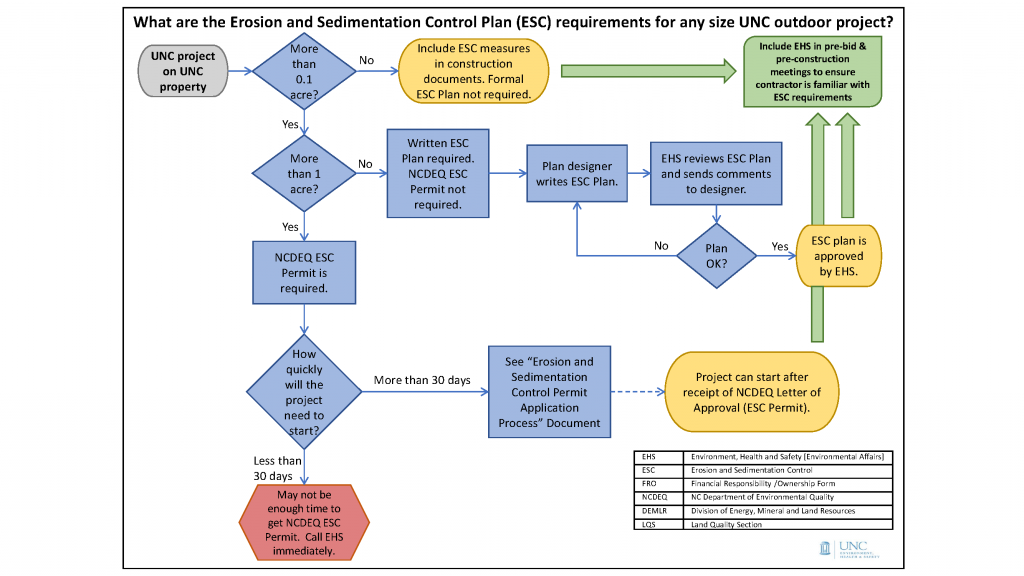Design Requirements
Guidance Documents
- Requirements Flowchart
- Permit Application Process, UNC Project on UNC Property
- Permit Application Process, Non-UNC Project on UNC Property
- Guidelines for Construction Projects
- Stormwater Requirements for Small Construction Projects
- Spill Prevention Control and Countermeasure (SPCC) Plan Construction Site Guidelines
- Chapel Hill/Carrboro Soil Stabilization Mix
- NC Department of Environmental Quality: NPDES Stormwater Permit for Construction Activities (NCG01)
Projects
The ESC Plan must meet all of the requirements of the Guidelines for Construction Projects. Once DEQ issues the permit, the project will be required to follow all conditions of the NC NPDES General Permit NCG 010000. The permit must be kept onsite at all times throughout the duration of the construction project.

When Should the Project Manager Contact EHS?
The project manager should involve EHS Environmental Affairs early in the design process. EHS will verify the project area to determine whether an ESC permit will be required, and will work with the project manager and designer to ensure that the ESC plan development and review process flows seamlessly.
UNC vs. Non-UNC Projects
All construction or land-disturbing projects that will be located on UNC-Chapel Hill property are subject to UNC-Chapel Hill’s ESC requirements, regardless of the size of the project or the organization financing the construction.
Construction Contractor, Fuel and Oil Management
In addition to the ESC plan, contractors working on UNC construction projects must adhere to theSpill Prevention Control and Countermeasure (SPCC) Plan Construction Site Guidelines for management of all fuel or oil in containers 55 gallons or greater in size.
Examples of Land Disturbing Activities Requiring ESC Plan and/or Permit
- Typical construction project
- Removing asphalt and/or concrete
- Synthetic turf field replacement
- Trenching for utility installation or removal
- Building demolition
- Outdoor staging for an interior construction project
Contact
UNC-Chapel Hill’s guidelines reference the statewide Stormwater Design Manual and provide more detailed requirements for implementation. Designers should note that since 2011, UNC is subject to the State and Federal Entities New Development rules for Jordan Lake. These are perhaps the most stringent water quality rules in the state of North Carolina.
The requirements are part of the University Design Guidelines.
Contact
Environmental Assessment/Finding of No Significant Impact (EA/FONSI) Process
Wetlands and Streams
Wetlands and streams that may be impacted by projects need to be delineated and permitted. Contact Environment, Health and Safety for more information about delineation and permitting on campus. This includes a requirement that UNC-Chapel Hill staff accompany the consultant on visits in conjunction with the regulators. Also, see the websites for the US Army Corps of Engineers and the NC Department of Environmental Air Quality 401 Wetlands and Buffer Permitting Program.
NCDEQ Jordan Lake Stream Buffer Regulations
As a State entity, UNC-Chapel Hill is subject to the Jordan Lake Stream Buffer rules as implemented by NCDEQ.
Town of Chapel Hill Stream Buffer Regulations
The Town of Chapel Hill has stream buffer requirements that are more stringent than DEQ’s requirements. These buffer requirements are part of the Town’s Resource Conservation District (RCD).
Town of Carrboro Stream Buffer Regulations
The Town of Carrboro’s stream buffer regulations are applicable to all University projects within Carrboro’s boundaries. These can be found in the Town’s Land Use Ordinance, Article XVI.
